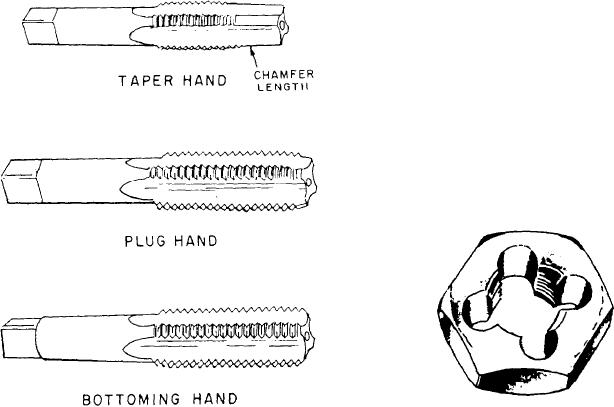
you to use while working on GTEs. You might,
The FLARE NUT wrench (fig. 3-4, view B)
however, use them elsewhere for maintenance.
is similar to a box wrench. The difference is a slot
The ADJUSTABLE wrench is useful because
cut in the wrench head which allows it to fit over
it will fit nuts and bolts that are odd-sized or
tubing or wiring and then onto the fastener. There
slightly damaged or burred. BUT, good engineer-
are two types of this wrench you might use on
ing practice dictates that you use the proper size
your ship. The first type is long handled, similar
wrench for the work you are doing. Parts on the
to the regular box wrench, with a different size
GTEs are made of high-quality materials and are
on each end. The second type is short. The other
standard sizes. Because of the design of the
end is designed to accommodate accessories, such
adjustable wrench, it could cause extensive
as extensions, breaker bars, and torque wrenches.
damage to the GTE. If it slips, gouging and/or
These flare nut wrenches are made with 6, 8, 12,
scratching could occur. Do not use a part if it is
and 16 points or notches. The wrenches on your
damaged in any way.
ship will generally be 12 points because of the
DO NOT use CADMIUM-PLATED or
numerous 12-point fasteners used on the GTE.
SILVER-PLATED hand tools when working on
You can also use the 12-point wrench effectively
titanium parts of GTEs. If you use these hand
on 6-point (hex head) fasteners. As with the
tools, you could cause particles of cadmium or
crowfoot wrenches, the flare nut wrenches come
silver to become imbedded in the titanium parts.
in a wide variety of sizes.
At temperatures above 600F, the cadmium or
The TORQUE ADAPTER wrench (fig. 3-4,
silver can cause embrittlement. This results in
view C) is similar to a box wrench. The other end
overstressed areas and possible cracking. To
is designed to accommodate accessories, such as
prevent this, use chrome-plated, nickel-plated, or
extensions, breaker bars, and torque wrenches.
unplated hand tools on titanium parts.
They are used to reach nuts and bolts that are in
hard to reach locations.
TAPS AND DIES
Nonrecommended Wrenches
and Hand Tools
Taps and dies are used to cut threads in metal,
plastics, or hard rubber. The taps are used for
The adjustable wrench and cadmium-plated
cutting internal threads, and the dies are used to
or silver-plated tools are NOT recommended for
cut external threads. Many different types of taps
are available. However, the most common are the
taper, plug, and bottoming (fig. 3-5).
The taper (starting) hand tap has a chamfer
length of 8 to 10 threads. You would use these
taps when starting a tapping operation and when
tapping through holes.
Plug hand taps have a chamfer length of 3 to 5
threads and are designed for use after the taper
tap.
Bottoming hand taps are used for threading
the bottom of a blind hole. They have a very short
chamfer length of only 1 to 1 1/2 threads. This
Figure 3-6.--Rethreading die.
Figure 3.5.--Types of common taps.
3-4

